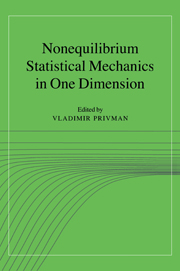Book contents
- Frontmatter
- Contents
- Contributors
- Preface
- Part I Reaction-Diffusion Systems and Models of Catalysis
- Part II Kinetic Ising Models
- Part III Ordering, Coagulation, Phase Separation
- Part IV Random Adsorption and Relaxation Processes
- Part V Fluctuations in Particle and Surface Systems
- Part VI Diffusion and Transport in One Dimension
- Part VII Experimental Results
- 20 Diffusion-limited exciton kinetics in one-dimensional systems
- 21 Experimental investigations of molecular and excitonic elementary reaction kinetics in one-dimensional systems
- 22 Luminescence quenching as a probe of particle distribution
- Index
- Abbreviations
21 - Experimental investigations of molecular and excitonic elementary reaction kinetics in one-dimensional systems
Published online by Cambridge University Press: 18 December 2009
- Frontmatter
- Contents
- Contributors
- Preface
- Part I Reaction-Diffusion Systems and Models of Catalysis
- Part II Kinetic Ising Models
- Part III Ordering, Coagulation, Phase Separation
- Part IV Random Adsorption and Relaxation Processes
- Part V Fluctuations in Particle and Surface Systems
- Part VI Diffusion and Transport in One Dimension
- Part VII Experimental Results
- 20 Diffusion-limited exciton kinetics in one-dimensional systems
- 21 Experimental investigations of molecular and excitonic elementary reaction kinetics in one-dimensional systems
- 22 Luminescence quenching as a probe of particle distribution
- Index
- Abbreviations
Summary
It has been well established by theory and simulations that the reaction kinetics of diffusion-limited reactions can be affected by the spatial dimension in which they occur. The types of reactions A + B → C, A + A → A. and A + C → C have been shown, theoretically and/or by simulation, to exhibit nonclassical reaction kinetics in 1D. We present here experimental results that have been collected for effectively 1D systems.
An A + B → C type reaction has been experimentally investigated in a long, thin capillary tube in which the reactants, A and B, are initially segregated. This initial segregation of reactants means that the net diffusion is along the length of the capillary only, making the system effectively 1D and allowing some of the properties of the resulting reaction front to be studied. The reaction rates of molecular coagulation and excitonic fusion reactions, A + A → A, well as trapping reactions, A + C → C, were observed via the phosphorescence (P) and delayed fluorescence (F) of naphthalene within the channels of Nuclepore membranes and Vycor glass and in the isolated chains of dilute polymer blends. In these experiments, the nonclassical kinetics is measured in terms of the heterogeneity exponent, h, from the equation rate ∼ F = kt-hPn, which gives the time dependence of the rate coefficient. Classically h = 0, while h = 1/2 in ID for A + A → A as well as A + C → C type reactions.
- Type
- Chapter
- Information
- Nonequilibrium Statistical Mechanics in One Dimension , pp. 421 - 442Publisher: Cambridge University PressPrint publication year: 1997



